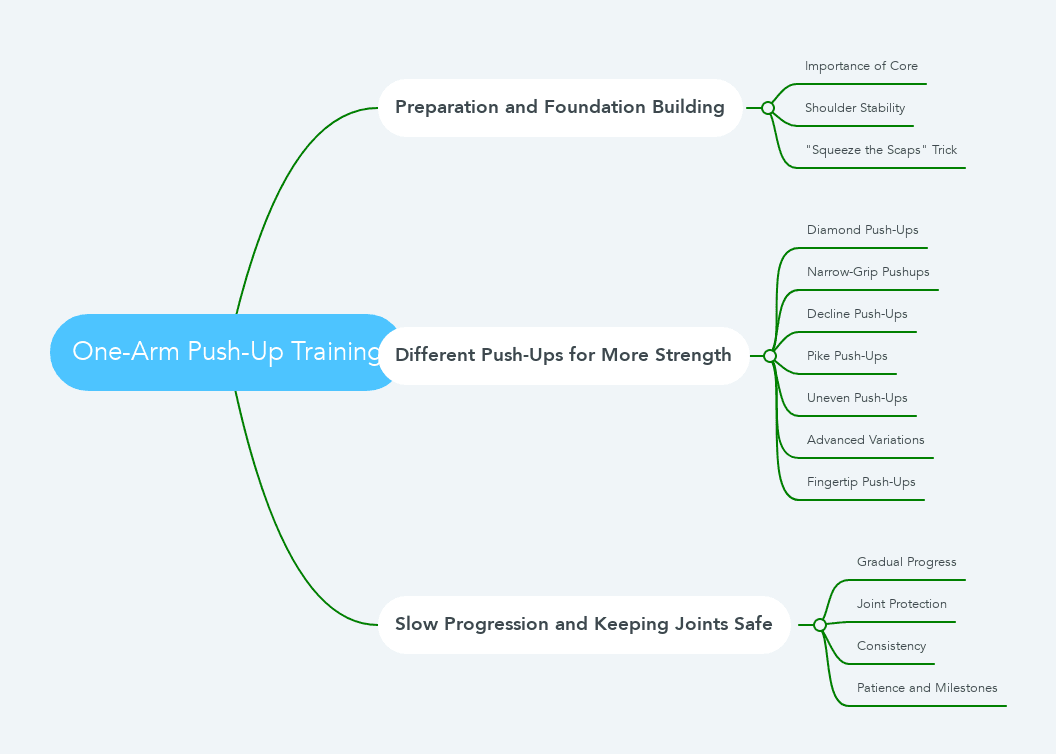Understanding the One Arm Push-Up
The Mechanics of the One Arm Push-Up
The goal here is simple: push your body up and down using just one arm. This move isn't just about being strong; it's also about knowing how to move and control your body. During a one-arm push-up, you use your chest, shoulders, triceps, and core muscles all at once. These muscles help keep your body straight and stop it from twisting.
Paying attention to how you move your shoulder blades is key. When pushing up, spread them apart. When going down, pull them together. Your elbow should make a 45-degree angle with your side to keep the strain off your joints while working out the right muscles.
Benefits and Challenges
One big plus of the one-arm push-up is it makes you more balanced and stable. Since you're lifting all your weight with one arm, your core has to work extra hard to keep you from falling over. This exercise also helps you get better at knowing where your body is in space, which is great for moving smoothly and avoiding falls.
It's also good for making your shoulders stronger and more stable, which can help stop injuries. If one side of your body is stronger than the other, this exercise can make both sides equally strong by working them out one at a time.
For anyone playing sports that involve swinging or throwing, like tennis or baseball, doing one-arm push-ups can help improve how well you play. These exercises are similar to real-life movements like pushing something heavy or getting up off the ground using one arm.
However, doing a one-arm push-up isn't easy. It requires a lot of upper body strength and control that might take some time to build up. But don't worry; there are simpler exercises you can start with to get stronger gradually.
Another great thing about one-arm push-ups? You don't need any special equipment or a gym membership. You can do them anywhere—perfect for staying fit at home or when traveling.
Preparation and Foundation Building

Strong Core and Shoulders
Having a strong middle part of your body isn't just about looking good. It helps keep your shoulders right and stable when you do a one-arm push-up. Work on exercises that make not just your abs but also the muscles around your shoulder blades stronger. Keeping your shoulder muscles healthy is important to avoid getting hurt.
A simple trick is the "Squeeze the Scaps," where you pretend to squeeze something between your shoulder blades while doing a push-up. This helps turn on the right muscles for a solid push-up.
Different Push-Ups for More Strength
Before you try a one-arm push-up, it's smart to try different kinds of push-ups. These help make your routine more fun and build up the muscles you need bit by bit.
Start with Diamond Push-Ups for stronger triceps, then try Narrow-Grip Pushups for an extra challenge. Decline Push-Ups make your upper body work harder by putting more weight on it. Pike Push-Ups focus on your shoulders, and Uneven Push-Ups with one hand higher than the other make your core and balance better.
Adding moves like Archer Push-Up, Typewriter Push-Up, Circular Push-Up, and Deficit Push-Ups will get your body ready for the tough move of a one-arm push-up. And yes, doing fingertip push-ups is useful—they make your fingers, wrists, and forearms stronger, which helps support you in that one-arm goal.
Slow Progression and Keeping Joints Safe
Jumping straight into a one-arm push-up without being ready can lead to disappointment or injury. Take it slow; start with easier versions and only move on when you've got those down pat. This way protects your joints while slowly making you stronger.
Sticking with it is key—make these exercises part of your usual workout to see better strength and technique over time. And remember to be patient; every small step forward is worth celebrating.
Technique and Form
Starting Position and Body Alignment
Start with your shoulder right above your wrist, placing your hand a bit outside your chest, level with your nipples. Spread your feet wider than your shoulders for a steady base. Keep your back straight, not arched or rounded, to stay stable.
Your shoulder blades should be pulled back and down, lining up with your spine. This helps you push up more effectively. Make sure the muscles between your shoulder blades and the large muscles on your back (latissimus dorsi) are working by lifting the arm that's not doing the push-up behind you. Aim for a straight line from head to toe, using your core muscles to keep stable like a tripod with your arm and feet.
Movement and Muscle Engagement
Keep your elbows close to your body to protect your shoulders and stay steady. When going down, move smoothly, keeping your back straight without letting your hips drop.
This exercise works out several key muscle groups including the chest, triceps, and front shoulder muscles. Focus on these areas to make the most of the push-up. Doing stretches for your chest can also help you move better and engage more muscle.
Common Mistakes to Avoid
Watch out for these common slip-ups:
- Stretching Elbows Too Much: Keep a slight bend in them through the move.
- Raising Shoulders: Keep them down away from your ears to avoid neck strain.
- Twisting Your Body: Stay in a straight line from head to toe; twisting could hurt.
- Touching Your Body with the Free Arm or Dropping Hips: These mistakes throw off balance and stability. Keep hips in line with everything else.
Progression Strategies

Building Strength and Technique
Starting strong is crucial, especially for one-arm push-ups. First, get good at regular push-ups, aiming for more than 30 reps. This builds the base strength you need and helps you nail the right form. Once you've got that down, move on to push-ups with your elbows close to your body to build even more strength, again hitting over 30 reps if you can.
Using the 5x5 method (five sets of five reps) three times a week is great for building muscle and getting stronger. This approach not only makes your muscles bigger but also boosts your stamina and performance.
To get better at one-arm push-ups, slowly make them harder. This helps improve the connection between your brain and muscles, making sure you're really working those muscles hard.
One-arm push-ups work out a lot of different muscles at once, like your core, chest, shoulders, and triceps. They're great for making you stronger all over and fixing any muscle imbalances. You can use things like a basketball for easier versions of one-arm push-ups until you're ready to do them without any help.
Advanced Variations and Challenges
To keep things interesting and challenging, try tougher versions like lever push-ups or plyometric (jumping) push-ups. These help build explosive power and make your shoulders stronger. Also, doing core exercises like planks or Russian twists is good because a strong core supports doing one-arm push-ups well.
You can work up to doing full one-arm push-ups by gradually making exercises harder. Try lifting one leg or doing one-arm positive (lowering yourself slowly) push-ups to get better at balancing and using your core.
Mixing in other exercises like kettlebell swings or pull-ups helps too by building overall strength which supports your one-arm push-up progress.
Changing how high or what surface you do your push-ups on can also make them more challenging and keep improving your strength.
Personalizing Your Progression
It's important to adjust your training plan to fit you perfectly since everyone's different in terms of fitness levels and goals. A plan that works well for someone else might not be right for you because of different strengths or limits.
Changing up your plan based on what works best for you ensures that you're challenging yourself without pushing too hard. Eating right for training can also make a big difference in reaching your goals.
Doing one-arm push-up practice at the start of your workout sessions is a good idea so you have the most energy and focus. Listening to what your body needs is key; always put safety first and change up your routine as needed to keep making progress without getting hurt.








